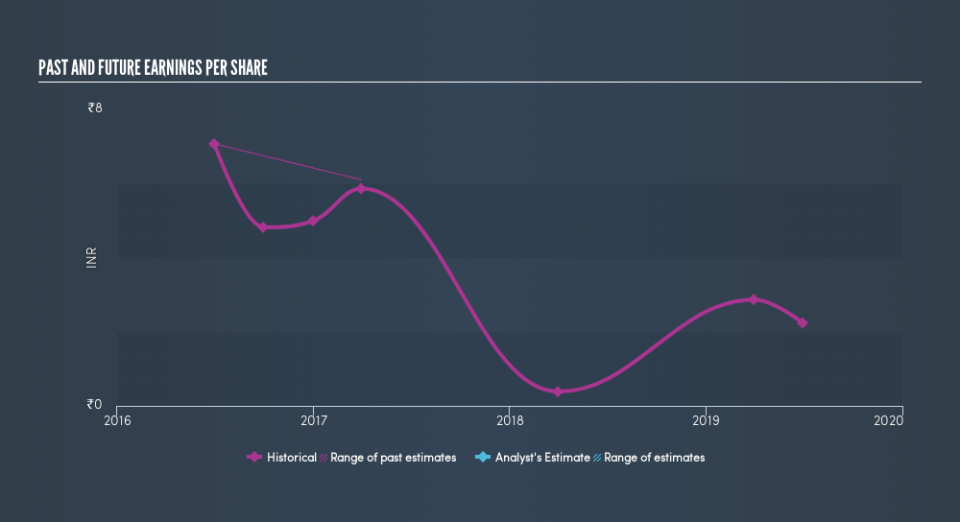Did Changing Sentiment Drive India Financial Services's (NSE:PFS) Share Price Down A Painful 73%?

Generally speaking long term investing is the way to go. But no-one is immune from buying too high. Zooming in on an example, the PTC India Financial Services Limited (NSE:PFS) share price dropped 73% in the last half decade. That is extremely sub-optimal, to say the least. And some of the more recent buyers are probably worried, too, with the stock falling 32% in the last year. The falls have accelerated recently, with the share price down 26% in the last three months.
View our latest analysis for India Financial Services
In his essay The Superinvestors of Graham-and-Doddsville Warren Buffett described how share prices do not always rationally reflect the value of a business. By comparing earnings per share (EPS) and share price changes over time, we can get a feel for how investor attitudes to a company have morphed over time.
During the five years over which the share price declined, India Financial Services's earnings per share (EPS) dropped by 12% each year. Readers should note that the share price has fallen faster than the EPS, at a rate of 23% per year, over the period. This implies that the market was previously too optimistic about the stock. The less favorable sentiment is reflected in its current P/E ratio of 5.46.
The graphic below depicts how EPS has changed over time (unveil the exact values by clicking on the image).
We know that India Financial Services has improved its bottom line lately, but is it going to grow revenue? Check if analysts think India Financial Services will grow revenue in the future.
What About Dividends?
When looking at investment returns, it is important to consider the difference between total shareholder return (TSR) and share price return. The TSR is a return calculation that accounts for the value of cash dividends (assuming that any dividend received was reinvested) and the calculated value of any discounted capital raisings and spin-offs. It's fair to say that the TSR gives a more complete picture for stocks that pay a dividend. In the case of India Financial Services, it has a TSR of -69% for the last 5 years. That exceeds its share price return that we previously mentioned. The dividends paid by the company have thusly boosted the total shareholder return.
A Different Perspective
While the broader market lost about 13% in the twelve months, India Financial Services shareholders did even worse, losing 32% (even including dividends). Having said that, it's inevitable that some stocks will be oversold in a falling market. The key is to keep your eyes on the fundamental developments. Unfortunately, last year's performance may indicate unresolved challenges, given that it was worse than the annualised loss of 21% over the last half decade. Generally speaking long term share price weakness can be a bad sign, though contrarian investors might want to research the stock in hope of a turnaround. Before forming an opinion on India Financial Services you might want to consider the cold hard cash it pays as a dividend. This free chart tracks its dividend over time.
Of course India Financial Services may not be the best stock to buy. So you may wish to see this free collection of growth stocks.
Please note, the market returns quoted in this article reflect the market weighted average returns of stocks that currently trade on IN exchanges.
We aim to bring you long-term focused research analysis driven by fundamental data. Note that our analysis may not factor in the latest price-sensitive company announcements or qualitative material.
If you spot an error that warrants correction, please contact the editor at editorial-team@simplywallst.com. This article by Simply Wall St is general in nature. It does not constitute a recommendation to buy or sell any stock, and does not take account of your objectives, or your financial situation. Simply Wall St has no position in the stocks mentioned. Thank you for reading.

